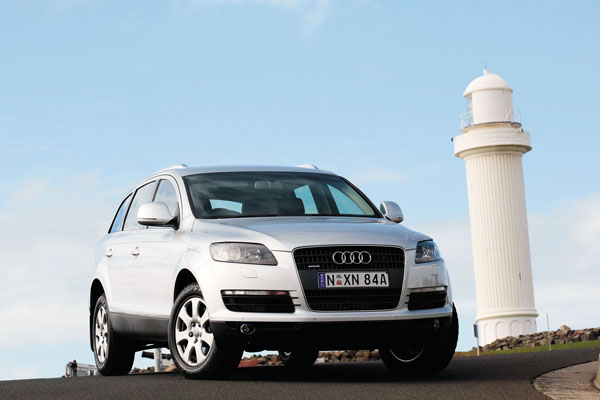
2006 Audi Q7
The Audi Q7 was first imported to Australia in 2006. Unlike an ever-increasing number of
other vehicles in this field it was designed as a reasonably serious 4WD not simply a
people mover dressed up to look Tuff.
So good was that first Audi Q7 that it lasted for close to a decade, with the second
generation not being released in Europe until 2015.
However, the second-generation Audi Q7 leans more in the direction of family wagon than
at conquering the great Aussie bush and our seemingly endless deserts. But it still
retained good off-road traction using the high-tech electronics that decide which wheels
can handle the most drive and juggling between them.
Interestingly, the Q7 is available as a five-, six- or seven-seater. The six-seat version was
ignored by most and a large percentage of new car buyers went for the seven seaters.
Interior space is good, though as is usually the way the third row is best left for the junior
travellers.
Initially, Q7 was available in Australia with a choice of a 171 kW 3.0-litre, six-cylinder
turbo-diesel engine, or a 257 kW 4.2-litre petrol V8. A 3.6-litre V6 petrol engine developing
206 kW was added to the range a few weeks after the diesels.
In September 2010 the 3.6 V6 petrol was replaced by a V6 supercharged unit displacing
3.0 litres and producing 245 kW. The V8 petrol was also discontinued at this time.
If you think that too much grunt isn’t enough you may care to buy a 6.0-litre V12 turbo-
diesel with a 1000 Newton metres – yes, 1000Nm – of torque! It went on sale here
November 2009. With a price tag of over a quarter of a million dollars these weren’t big
sellers off the import list midway through 2012.
Engines were mated to a six-speed tiptronic automatic until the 2010 makeover, when an
eight-speed conventional automatic transmission was installed. Both automatics have
Tiptronic manual shifts for those who prefer to select their own gears.
2011 Audi Q7
The hot variant, the Audi SQ7 is powered by 4.0-litre V8 diesel engine with two variable-
geometry turbochargers that can produce up to 2.4 bar of boost pressure. It uses an
electrically powered compressor (EPC) to blow air into one of the diesel turbochargers to
reduce turbo lag.
The 48-Volt EPC spins up to its full 70,000 rpm within a quarter of a second and helps the
exhaust powered compressor up to speed with the added air.
A petrol-powered 55 TFSI S Line was introduced early in 2021 but is too recent to cover in
this Used Car Checkout.
There are quite a few Audi dealers in Australia. Most are in metro regions but dealers are
increasing in numbers in major country cities as well as some large country towns.
These are complex vehicles and we suggest owners only tackle the most basic of repair
and servicing work themselves. It makes sense to use only professionals with training by
Audi.
Insurance premiums are about average for an upmarket European model and there is
seldom a great deal of difference in charges from one company to another. If shopping
around for the best insurance deal make sure you understand the exact comparisons from
company to company.
WHAT TO LOOK FOR
A full-service record showing everything was done on time or by distance travelled,
whichever comes first, is important.
Make sure the engine starts quickly and idles smoothly even when it’s cold. If possible, do
this after the engine has been stopped overnight.
2016 Audi Q7
Ask if you can take it for a reasonably long test drive, not just a quick drive around the
block. If warning lights come on and off there could be major problems – pull over when it’s
safe and ring the seller. Better still, have the sales person or the owner sitting beside you
during your test drive.
Check the transmission doesn’t hunt up and down through the gears when it should be
holding onto a single gear.
People movers that do heavy-duty work carting kids can get seriously knocked about. It’s
smart to do the initial stages of your pre-purchase inspection by checking out the area
behind the front seats.
Look at the boot floor and sides as well as the backs of the rearmost seats for damage.
Uneven front tyre wear probably means a Q7 has been the subject of some hard driving by
an over enthusiastic driver. More seriously, it may also mean one of the wheels is out of
alignment caused by a hard thump against a kerb. Or, still worse, that it’s done some
heavy-duty off-road work.
HOW MUCH?
Budget on spanding from $8000 to $13,000 for a 2006 Audi Q7 3.0 TDI; $13,000 to
$19,000 for a 2007 3.6 FSI; $16,000 to $23,000 for a 2009 3.6 TDI; $23,000 to $31,000 for
a 2013 3.0 TDI; $30,000 to $41,000 for a 2014 4.2 TDI; $38,000 to $50,000 for a 2015 3.0
TDI; $42,000 to $57,000 for a 2010 6.0 TDI; $51,000 to $70,000 for a 2017 e-tron;
$65,000 to $89,000 for a 2018 50 TDI; $73,000 to $97,000 for a 2020 45 TDI; and $86,000
to $113,000 for 2021 55 TFSI.
CAR BUYING TIP
Keep an eye on the used car market for at least a month, two would be even better, to get
an idea of what is selling and what isn’t. That way you can often beat down the seller on
price.
RECALLS: To browse recalls on all vehicles go to the ACCC at:
www.productsafety.gov.au/products/transport/cars/